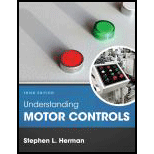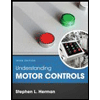
Understanding Motor Controls
3rd Edition
ISBN: 9781305498129
Author: Stephen L. Herman
Publisher: Cengage Learning
expand_more
expand_more
format_list_bulleted
Concept explainers
Question
Chapter 41, Problem 14RQ
To determine
The type of temperature switch TS3 used in the circuit shown in Figure 41-14.
Expert Solution & Answer
Trending nowThis is a popular solution!

Students have asked these similar questions
What are the accompanving boundary conditions for this bar?
1.1 Consider the fireclay brick wall of Example 1.1 that is
operating under different thermal conditions. The tem-
perature distribution, at an instant in time, is T(x) = a+
bx where a 1400 K and b = -1000 K/m. Determine
the heat fluxes, q", and heat rates, q, at x = 0 and x = L.
Do steady-state conditions exist?
2.4 To determine the effect of the temperature dependence
of the thermal conductivity on the temperature dis-
tribution in a solid, consider a material for which this
dependence may be represented as
k = k₁ + aT
where k, is a positive constant and a is a coefficient that
may be positive or negative. Sketch the steady-state
temperature distribution associated with heat transfer
in a plane wall for three cases corresponding to a > 0,
a = 0, and a < 0.
Chapter 41 Solutions
Understanding Motor Controls
Ch. 41 - To answer the following questions refer to the...Ch. 41 - To answer the following questions refer to the...Ch. 41 - Prob. 3RQCh. 41 - To answer the following questions refer to the...Ch. 41 - To answer the following questions refer to the...Ch. 41 - Prob. 6RQCh. 41 - To answer the following questions refer to the...Ch. 41 - To answer the following questions refer to the...Ch. 41 - Prob. 9RQCh. 41 - Prob. 10RQ
Knowledge Booster
Learn more about
Need a deep-dive on the concept behind this application? Look no further. Learn more about this topic, mechanical-engineering and related others by exploring similar questions and additional content below.Similar questions
- 1.21 A one-dimensional plane wall is exposed to convective and radiative conditions at x = 0. The ambient and sur- rounding temperatures are T = 20°C and Tur = 40°C, respectively. The convection heat transfer coefficient is h=20 W/m² K, and the absorptivity of the exposed sur- face is α=0.78. Determine the convective and radiative heat fluxes to the wall at x = 0 if the wall surface tem- perature is T, = 24°C. Assume the exposed wall surface is gray, and the surroundings are large.arrow_forward1.12 You've experienced convection cooling if you've ever extended your hand out the window of a moving vehi- cle or into a flowing water stream. With the surface of your hand at a temperature of 30°C, determine the con- vection heat flux for (a) a vehicle speed of 40 km/h in air at -8°C with a convection coefficient of 40 W/m² K and (b) a velocity of 0.2 m/s in a water stream at 10°C with a convection coefficient of 900 W/m²K. Which condition would feel colder? Contrast these results with a heat flux of approximately 30 W/m² under normal room conditions.arrow_forwardPLEASE SOLVE STEP BY STEP WITHOUT ARTIFICIAL INTELLIGENCE OR CHATGPT SOLVE BY HAND STEP BY STEParrow_forward
- 1. A 40 lb. force is applied at point E. There are pins at A, B, C, D, and F and a roller at A. a. Draw a FBD of member EFC showing all the known and unknown forces acting on it. b. Draw a FBD of member ABF showing all the known and unknown forces acting on it. c. Draw a FBD of member BCD showing all the known and unknown forces acting on it. d. Draw a FBD of the entire assembly ADE showing all the known and unknown forces acting on it. e. Determine the reactions at A and D. f. Determine the magnitude of the pin reaction at C. 40 lbs. B A 6 in. 4 in. D F -5 in.4 in 4.arrow_forwardA crude oil of specific gravity0.85 flows upward at a volumetric rate of flow of 70litres per second through a vertical venturimeter,with an inlet diameter of 250 mm and a throat diameter of 150mm. The coefficient of discharge of venturimeter is 0.96. The vertical differences betwecen the pressure toppings is 350mm. i) Draw a well labeled diagram to represent the above in formation i) If the two pressure gauges are connected at the tapings such that they are positioned at the levels of their corresponding tapping points, determine the difference of readings in N/CM² of the two pressure gauges ii) If a mercury differential manometer is connected in place of pressure gauges, to the tappings such that the connecting tube up to mercury are filled with oil determine the difference in the level of mercury column.arrow_forwardCan you solve it analytically using laplace transforms and with Matlab code as well please. Thank Youarrow_forward
- Can you solve it analytically using laplace transforms and with Matlab code as well please. Thank You.arrow_forwardQ11. Determine the magnitude of the reaction force at C. 1.5 m a) 4 KN D b) 6.5 kN c) 8 kN d) e) 11.3 KN 20 kN -1.5 m- C 4 kN -1.5 m B Mechanical engineering, No Chatgpt.arrow_forwardplease help with this practice problem(not a graded assignment, this is a practice exam), and please explain how to use sohcahtoaarrow_forward
arrow_back_ios
SEE MORE QUESTIONS
arrow_forward_ios
Recommended textbooks for you
 Understanding Motor ControlsMechanical EngineeringISBN:9781337798686Author:Stephen L. HermanPublisher:Delmar Cengage Learning
Understanding Motor ControlsMechanical EngineeringISBN:9781337798686Author:Stephen L. HermanPublisher:Delmar Cengage Learning Electrical Transformers and Rotating MachinesMechanical EngineeringISBN:9781305494817Author:Stephen L. HermanPublisher:Cengage Learning
Electrical Transformers and Rotating MachinesMechanical EngineeringISBN:9781305494817Author:Stephen L. HermanPublisher:Cengage Learning Understanding Motor ControlsMechanical EngineeringISBN:9781305498129Author:Stephen L. HermanPublisher:Cengage Learning
Understanding Motor ControlsMechanical EngineeringISBN:9781305498129Author:Stephen L. HermanPublisher:Cengage Learning

Understanding Motor Controls
Mechanical Engineering
ISBN:9781337798686
Author:Stephen L. Herman
Publisher:Delmar Cengage Learning

Electrical Transformers and Rotating Machines
Mechanical Engineering
ISBN:9781305494817
Author:Stephen L. Herman
Publisher:Cengage Learning

Understanding Motor Controls
Mechanical Engineering
ISBN:9781305498129
Author:Stephen L. Herman
Publisher:Cengage Learning